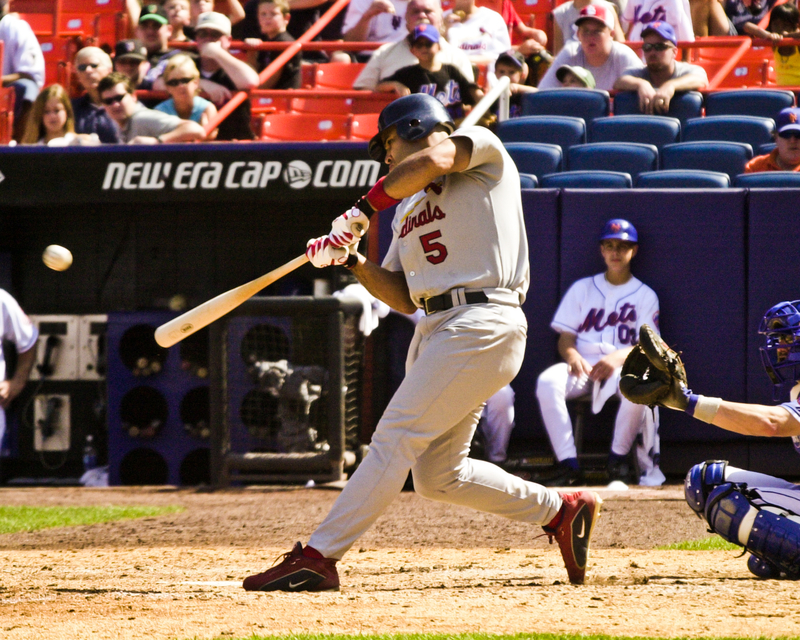Last updated on October 27th, 2023 at 06:16 am
RBI stands for “runs batted in” for a baseball player. There are numerous ways to drive in a run during a game, including a single, walk, a homerun, and much more. In fact, recording an out that drives in a run result in an RBI for that player, which helps showcase their value as a run producing player.
So, what does RBI stand for in baseball in more detail? What are some examples of when an RBI will occur during a baseball game? What are some reasons that a player won’t receive an RBI? Is there a good RBI number to get at the end of the year in the MLB? How is the RBI stat different from OPS? How is RBI different from a player’s batting average? Finally, what are some flaws with the RBI stat in baseball?
Here is the complete breakdown to RBI (runs batted in) in baseball.
Examples of an RBI Situations in an MLB Game
- Hitting a base hit that scores a runner who is already on base.
- Hitting a sacrifice fly via a fly ball or ground out, a sacrifice bunt like a suicide squeeze, or getting into a fielder’s choice that drives in a run.
- A home run counts as an RBI for you, along with whoever scored on that play.
- Walking or getting hit by a pitch that drives in a run counts as an RBI.
Reasons You Don’t Receive an RBI Credit
- The defense team makes an error like dropping a pop fly in the outfield or throwing the ball away on a play that brings in a run.
- Grounding into a double play that scores a run.
- A runner stealing home while you are at plate won’t count via runs batted in.
- A wild pitch from the pitcher that brings home a run.
- A balk that results in a run-scoring play.
What is a Good RBI Total in Baseball?
A good RBI total depends on where you bat in the batting order on your team. For example, a leadoff hitter’s job is to get on base to allow others to drive them into home plate. Getting on the base gives the next hitter a chance for an RBI. In that case, your number three or fourth hitter will tend to have more RBI opportunities to hit in than a traditional leadoff hitter with nobody on base to start a game.
While there is no universal good RBI total, anything over 100 during a season for hitters in the cleanup role is excellent. However, it makes the most sense to compare leadoff hitters against other team’s leadoff hitters if you want to compare players via RBI totals. Comparing a leadoff hitter against your cleanup hitter wouldn’t be a fair comparison if you were only looking at total RBIs.
Who Had the Most RBI’s in a Regular Season?
Hack Wilson has the most RBI’s in a single season at 191. Below is the list of the top 5 players with the most RBI’s in a season. Check out the complete list from Baseball-Reference to see everyone.
- Hack Wilson at 191
- Lou Gehrig at 185
- Hank Greenberg at 184
- Jimmie Foxx at 175
- Lou Gehrig at 173
Who Has the Most RBI’s in their Career?
Hank Aaron has the most RBI’s in baseball with 2,297. Below is the list of the top 5 players with the most RBI’s in their careers. If you want the complete list of players with the most RBI’s, you can visit this link.
- Hank Aaron (Hall of Fame): 2,297
- Babe Ruth (Hall of Fame): 2,214
- Albert Pujols (active player in 2022): 2141
- Alex Rodriguez: 2,086
- Cap Anson (Hall of Fame) 2,075
How is RBI Different from a Player’s Batting Average?
The main difference between an RBI and a batting average is that the former measures how many runs a hitter produce during their at-bat, while the average batting measures if they got a base safely from hitting the ball. For example, hitting a home run gives a player an RBI and can help raise their batting average all in one swing. However, if the bases are loaded when they hit the home run, they receive 4 RBIs from that swing but only a one-hit credit for their batting average.
The two metrics differ entirely in the value of a sacrifice hit. For example, a sac fly that drives in a run will count as one RBI for that hitter. However, since the term is a sacrifice fly, the out won’t count negatively against a player’s batting average. Another way these two metrics differ is that a hitter who walks and drives in a run will also count as an RBI, but it won’t raise their average batting number.
Why Only Look at RBI Isn’t the Best Metric
From my experience watching baseball, focusing only on a player’s RBI total can be mislead. For instance, Barry Bonds walked intentionally 232 times in 2004, which took the bat out of his hands when he would come to the plate to hit. Sometimes teams would even walk Barry Bonds to bring in a run since they did not want Barry to hit, so those instances limited how many runs he could bat in during the season. Therefore, without looking at the complete picture, you might say that Barry Bond underachieved a bit in this category, which was more due to the number of walks he had.
Another issue with looking at the RBI stat column is that certain players in the lineup have more chances to drive in runs than others. For example, a leadoff hitter is typically not a home run hitter, so there won’t be anyone on base when they come to bat to start the game. Their goal is to become a baseman on the paths for another hitter in the lineup to drive them into home plate.
Finally, some hitters in the lineup set up another player to have an RBI chance. For example, a number nine hitter might bunt during their at-bat to move a baserunner into scoring. That means that the next hitter has an opportunity to drive in a run, but the last batter who dropped the sacrifice bunt won’t receive any credit for setting this opportunity in the first place.
Conclusion: What Does RBI Mean in Baseball?
In summary, measuring RBI’s is an excellent high-level view in measuring one team’s slugger against another team’s slugger. In theory, you want your slugger in the lineup to drive in the most runs for your team since they should have the most chances to hit with runners on base. While more detailed stats can measure the effectiveness of a hitter outside of RBI’s, measuring RBI’s is still a straightforward way to understand a slugger’s value.
Similar Posts
What is Tipping Pitches in Baseball?
What is the Strike Zone in Baseball?
What is a Blown Save in Baseball?
What is the Triple Crown Award in Baseball?
Greg Kristan, owner of The Stadium Reviews, LLC and TM Blast, LLC, brings his extensive experience visiting over half of the MLB ballparks, along with numerous MLS, NHL, NBA, and NFL venues, to provide in-depth coverage on the bag policy, food options, and parking. He has also been interviewed about his experiences on several sports podcasts.








